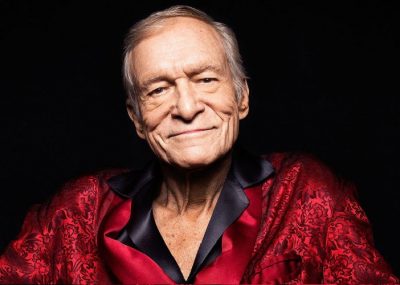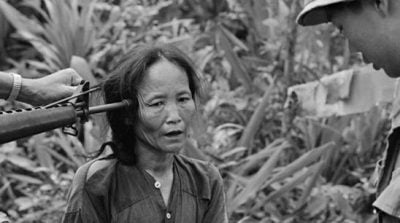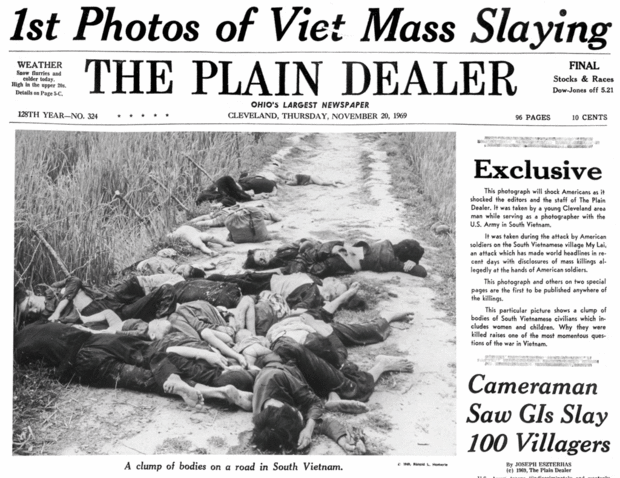“We are apt to shut our eyes against a painful truth…For my part, whatever anguish of spirit it might cost, I am willing to know the whole truth; to know the worst, and to provide for it.” —Patrick Henry, Virginia Convention, 23 March, 1775
“The completeness of the victory is established by this fact: that of the six hundred Moros (Muslims living in the southern Philippines at the beginning of the 20th century) not one was left alive. The brilliancy of the victory is established by this other fact, to wit: that of our six hundred heroes only fifteen lost their lives. General Leonard Wood was present and looking on. His order had been, ‘Kill or capture those savages.’ Apparently our little army considered that the ‘or’ left them authorized to kill or capture according to taste, and that their taste had remained what it has been for eight years – the taste of Christian butchers. . . .The enemy numbered six hundred – including women and children – and we abolished them utterly, leaving not even a baby alive to cry for its dead mother. This is incomparably the greatest victory that was ever achieved by the Christian soldiers of the United States.” – Mark Twain on the conduct of American soldiers in the Bud Dajo Massacre, March 5-8, 1906 (Philippine-American War), a war that has was conducted similarly to the Vietnam War 60 years later (a la the My Lai Massacre).
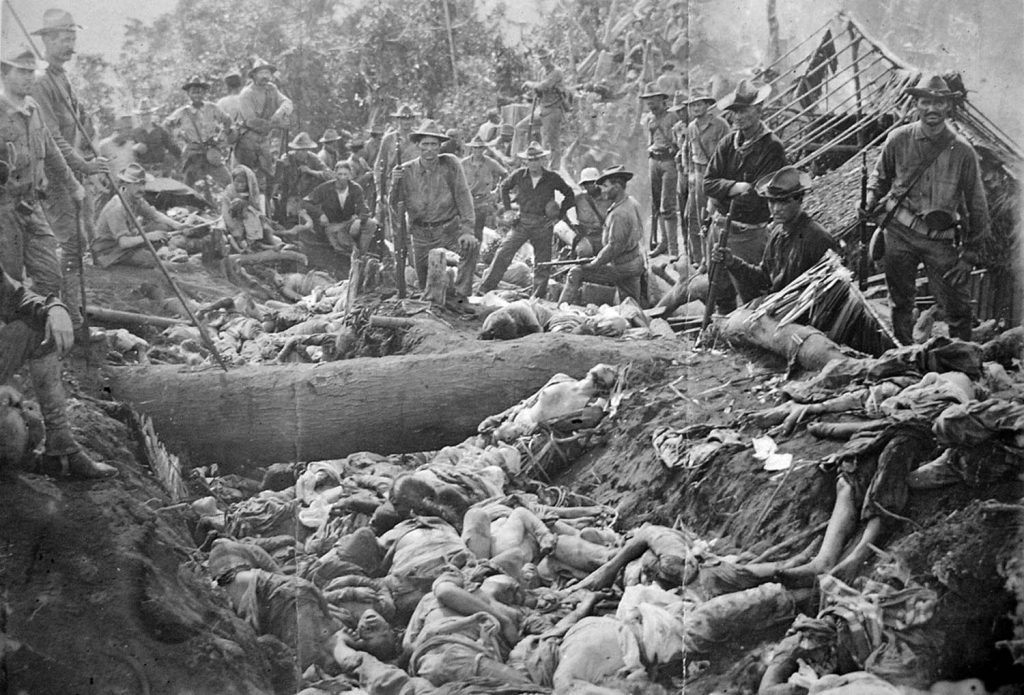
US soldiers pose with the bodies of Moro insurgents, Philippines, 1906
“War is just a racket…I spent most of my time being a high class muscle-man for Big Business, for Wall Street and for the Bankers. In short, I was a racketeer, a gangster…I helped make Mexico safe for American oil interests in 1914. I helped make Haiti and Cuba a decent place for the National City Bank boys to collect revenues in. I helped in the raping of half a dozen Central American republics for the benefits of Wall Street…Looking back on it, I feel that I could have given Al Capone a few hints…There isn’t a trick in the racketeering bag that the military gang is blind to. It has its ‘finger men’ to point out enemies, its ‘muscle men’ to destroy enemies, its ‘brain men’ to plan war preparations, and a ‘Big Boss’ – Super-Nationalistic Capitalism. It may seem odd for me, a military man to adopt such a comparison. Truthfulness compels me to.” – Major General Smedley Butler, 1934
“There may be a limit beyond which many Americans and much of the world will not permit the United States to go. The picture of the world’s greatest superpower killing or seriously injuring 1,000 non-combatants a week, while trying to pound a tiny, backward nation into submission on an issue whose merits are hotly disputed, is not a pretty one.” — Robert McNamara in a memo to Lyndon Johnson – May, 19, 1967
“Some scholars estimate that as many as 3.8 million Vietnamese died during the war. Up to 800,000 perished in Cambodia and another one million in Laos, neighboring countries into which the U.S. expanded the war. The U.S. death toll was 58,000, about half of them people of color. It was a racist war both home and abroad.” – Eric A. Gordon
“The systemic malady that produced the Vietnam War is a close cousin to the one that has now given us President Trump.” – Ira Chernus
First published photos of the My Lai Massacre. Up to 500 totally innocent women, children and babies had been rounded up and shot in cold blood. No weapons had been found in the village. Original story at cleveland.com.
I have been dutifully watching the well-publicized ten-episode, 18 hour-long PBS series on the War in Vietnam that is, as I write, just past the halfway point. The war in Vietnam was the war that I grew up being peripherally aware of (the draft laws hadn’t been implemented yet when I was in high school), but I didn’t think much about it because I was enrolled and very busy studying in med school (1964-1968) at the University of Minnesota when the Tet Offensive began.
Med students of that era were given automatic deferments from military conscription if they promised to practice medicine in rural Minnesota, which I had always planned to do anyway. Practicing rural medicine in my home state was a no-brainer for me, having grown up in a small town, and my decision was affirmed as I saw my fellow med students (at least those who were planning to specialize) struggling with the decision about signing up for the Berry Plan (that allowed them to finish their residencies risk-free but who were then obligated them to join the military immediately afterward – with some assurance of being able to practice their specialty in the military for a period of 4 years.
I was thus spared the psychologically-traumatizing and life- and brain-altering experience of being in a warzone where my likely mission as a physician would have been serving in a field hospital treating the victims of gunshot, artillery or explosive landmine or grenade wounds). Therefore, my life story is a lot different than the life stories of many of my classmates who went to war.
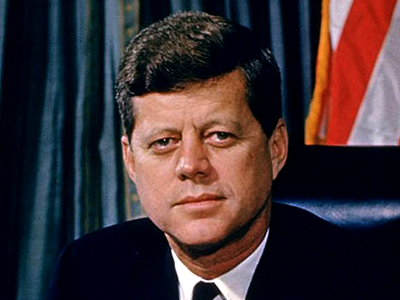 I graduated from med school in 1968, the year that “everything happened”, including the widespread American anti-war demonstrations, the Tet Offensive, Eugene McCarthy’s antiwar candidacy (that resulted in LBJ’s “abdication”), the My Lai Massacre (only revealed to the public a year and a half later), the scores of other My Lai-type Massacres (that were never revealed to the public), the “fragging” (murder by fragmentation grenade) of young, gung-ho, fresh-out-of West Point officers who unnecessarily put their more experienced troops in harm’s way, Martin Luther King’s assassination, DOD Secretary Robert McNamara’s resignation, Robert Kennedy’s assassination, “Tricky Dick” Nixon and Spiro Agnew getting the nomination at the GOP National Convention, the Chicago Riots at the Democratic National Convention, world-wide anti-Vietnam War demonstrations, race riots at home in response to MLK’s murder, demands for justice for minorities, women, etc., etc.
I graduated from med school in 1968, the year that “everything happened”, including the widespread American anti-war demonstrations, the Tet Offensive, Eugene McCarthy’s antiwar candidacy (that resulted in LBJ’s “abdication”), the My Lai Massacre (only revealed to the public a year and a half later), the scores of other My Lai-type Massacres (that were never revealed to the public), the “fragging” (murder by fragmentation grenade) of young, gung-ho, fresh-out-of West Point officers who unnecessarily put their more experienced troops in harm’s way, Martin Luther King’s assassination, DOD Secretary Robert McNamara’s resignation, Robert Kennedy’s assassination, “Tricky Dick” Nixon and Spiro Agnew getting the nomination at the GOP National Convention, the Chicago Riots at the Democratic National Convention, world-wide anti-Vietnam War demonstrations, race riots at home in response to MLK’s murder, demands for justice for minorities, women, etc., etc.
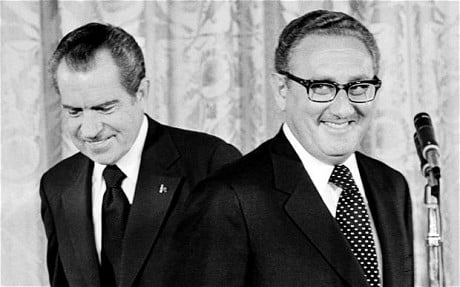 1968 was capped off in November with the sobering results of the presidential election, which showed proudly segregationist southern candidate Governor George Wallace of racist Alabama garnering 13.5% of the popular vote, despite splitting America’s right-wing racist vote with Richard Nixon (and the Republican Party’s “Southern Strategy”). Richard Nixon got 43.4 % of the popular vote, barely beating the 42.7% that the progressive, anti-racist (but pro-war) candidate Hubert Humphrey barely managed to get.
1968 was capped off in November with the sobering results of the presidential election, which showed proudly segregationist southern candidate Governor George Wallace of racist Alabama garnering 13.5% of the popular vote, despite splitting America’s right-wing racist vote with Richard Nixon (and the Republican Party’s “Southern Strategy”). Richard Nixon got 43.4 % of the popular vote, barely beating the 42.7% that the progressive, anti-racist (but pro-war) candidate Hubert Humphrey barely managed to get.
Richard Nixon with Henry Kissinger (left)
Like today’s Bernie or Bust voters, many progressive voters who usually voted Democratic had been cheated by the Democratic Party and had been battered and bruised by Chicago Boss Richard Daley’s unethical party machine (and its pro-war, police state tactics). Therefore many of those disillusioned progressives stayed home on election day, ensuring 4+ years of the futile, corrupted and doomed presidency of racist-leaning Republican Richard Nixon, whose first term produced an additional 20,000 American deaths in Vietnam and a much larger number of physical and emotional casualties and heroin addicts.
So, because of my interest in psychological trauma, I have been spending the decades since the Vietnam War trying to understand the dynamics of both the short-term and long-term negative mental health effects of combat-induced post-traumatic stress disorder – which wasn’t actually called PTSD until 1980, well after the end of the war. Even there was no accepted name, PTSD has existed since the first human with a weapon assaulted the first perceived enemy without a weapon in an argument over a property line, hunting ground or other possession.
Over the 40+ years of practicing medicine, I have come in contact with innumerable patients who were suffering from both domestic and war-related trauma-induced depression, anxiety, insomnia, functional disorders, flash-backs (usually mis-read as “hallucinations” and therefore mis-diagnosed as “schizophrenia”), etc.
In addition, I provided medical care for several years for the in-patients at a mental hospital,. During that time I came in contact with many over-medicated inpatients (invariably intoxicated with brain-altering, brain-suppressing cocktails of psychiatric drugs) – virtually all of whom had, at the beginning of their psychiatric misadventures, been victims of acute and/or chronic sexual, physical, emotional, spiritual or combat trauma. It seemed that few to none of these patients had had ever been questioned about any history of psychological trauma; and therefore their PTSD remained undiagnosed as their primary diagnosis – an important reality that would alter all future treatments or even any chances at a cure. And thus they were left with diagnoses “mental illness of unknown cause” which were destined to be treated primarily with drugs.
Later in my medical career, I spent some sabbatical time at the VA hospital at Fort Snelling and became familiar with the devastating effects suffered by Vietnam War veterans who had been belatedly but accurately diagnosed with combat-induced PTSD.
I also practiced medicine for a time at a VA out-patient clinic and dealt with traumatized veterans from every war since WWII. Sadly, I came to learn that these VA medical facilities were full of combat-traumatized war veterans (from every war) who were victims of mis-diagnoses such as paranoid schizophrenia of unknown cause, schizoaffective disorder of unknown cause or manic-depressive psychosis of unknown cause who therefore had been mis-treated with so-called anti-psychotic drugs like Thorazine, Prolixin or Mellaril until their brains had been so damaged that they had become totally disabled with drug-induced mental illness, drug-induced dementia, drug-induced suicidality, drug-induced tardive dyskinesia, drug-induced sleep disorders, drug-induced cardiac disorders, drug-induced gastrointestinal disorders, etc – all preventable disorders, as is true of combat-induced PTSD, rape-trauma-induced PTSD or any of the other trauma-related mental health disorders. An ounce of prevention is worth far more than a pound of cure. Ask any PTSD victim.
So I have gradually come to understand how important chronic stress is, especially life-threatening stress, and I know what it can do to a person’s brain and body. I have tried to warn those in my sphere of influence about the total preventability of combat-induced PTSD (simply never enter a combat zone). My generation’s war in Vietnam has produced so many haunted combat-traumatized Vietnam vets coming home to an uncomprehending society should still have taught the medical profession some hard lessons about violence and mental health. Sadly, indoctrinated war-makers, greedy war-profiteers and Big Pharma have all placed careers, duty, honor and profits ahead of human health, wellness and the avoidance of neurotoxic prescription drugs. But the temptation of our society to glorify American militarism has obfuscated the truth about war, to the great detriment of every one of us consumers and potential recruits.
Ken Burns has stated that the writers and producers of The Vietnam War made serious conscious efforts to present both the pro-war and the anti-war sides of the story, mistakenly presuming that there is any ethical equivalence between the two sides. Those balancing efforts are obvious, but even the testimony of the pro-war story-tellers can’t help but solidify the fact that the Vietnam War was an atrocity-producing situation that had no upside, unless one is talking about the points of view of amoral, sociopathic, war-mongers and other capitalist sympathizers.
There has been a lot of footage in this documentary that I had not seen before, so there will be segments that will enhance everybody’s knowledge about this important event. I also hope that folks will view the film with an open mind and with empathy for the victimized and with understanding for the victimizing soldiers. The victimized are represented by the innocent Vietnamese women, children and old men.
But the guilty, order-obeying young soldiers deserve some empathy also, for they had been lied to about the reasons that they were there with orders to kill in a hell zone, willing to do anything necessary in a desperate effort to survive or otherwise overcome the painful experience, even if it meant committing war crimes to do it – or taking brain-altering drugs or committing suicide.
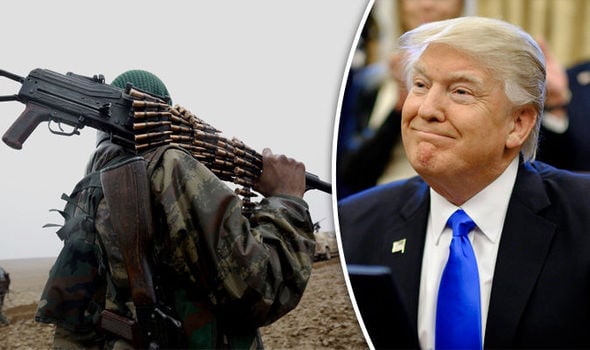 For those viewers who were already somewhat familiar with the Vietnam War, I hope that the experience will function as an important refresher course about this important phase of American and world history. Mistakes that mankind should have learned about from history’s fiascoes will be repeated most often by those who are ignorant of them. The current occupant of the Oval Office is unlikely to have learned any important lessons from history, especially about the nature of war. No confidence should be placed in his decision-making abilities.
For those viewers who were already somewhat familiar with the Vietnam War, I hope that the experience will function as an important refresher course about this important phase of American and world history. Mistakes that mankind should have learned about from history’s fiascoes will be repeated most often by those who are ignorant of them. The current occupant of the Oval Office is unlikely to have learned any important lessons from history, especially about the nature of war. No confidence should be placed in his decision-making abilities.
Hopefully younger people – especially those who may someday be tempted to sign up for the military – will be willing to tear themselves away from their hand-held electronic devices to watch this series and learn some of the lessons that even their president hasn’t learned yet. Their futures may depend on doing so, for just as World War I ruined entire generations of young military-age soldiers in England, France, Germany and Russia, the Vietnam War ruined the lives of an entire generation of immature, draft age adolescent boys – whether they died, were “just” wounded or came home seriously traumatized but with no visible wounds. The lives of combat soldiers through history were never the same again, and, if you asked their loved ones, they will tell you that the same can be said for them as well.
The damaged lives, damaged brains, damaged bodies, damaged marriages and faulty parenting methods experienced by Vietnam War veterans, their families – and their victims – have significant negative impacts on the mental and spiritual health of future generations of all those who have been touched, whether directly or indirectly, by war violence.
Our war-mongering nation has 900 unaffordable, fully-equipped and well-defended military bases outside our borders (as opposed to Russia’s 2 foreign bases) and
America has been involved in scores of regime changes and election-interference all around the world ever since 1898, when the US defeated Spain in the brief Spanish-American war (April 1898–August 1898).
It was after that war that the United States acquired Spain’s ex-colonies Puerto Rico, Guam and the Philippines and gave Cuba its independence (except for the Guantanamo Bay military base).
There is an eye-opening document that should wake up and then bring shame to every peace and justice-seeking individual that is concerned about America’s 20 trillion dollar debt and its trillion-dollar annual military expenditures (if one includes the interest payments on past war cost borrowing, the cost of our intelligence agencies, the cost of our nuclear weapons and the cost of providing health care to veterans). The document can be accessed here.
The document, written by historian Dr Zoltan Grossman of Evergreen College in Olympia, Washington, contains a comprehensive list of the scores of foreign interventions that the US military has made since the Massacre at Wounded Knee (1890).
From that website, I compiled the following list of the last 73 Nations that the US military has intervened in since the Korean War (aerial bombings, missiles, troops, command operations)
Korea (1950), Iran, Vietnam, Guatemala, Egypt, Lebanon, Iraq, China, Panama, Vietnam, Cuba, Germany, Laos, Cuba, Iraq, Panama, Indonesia, Dominican Republic, Guatemala, Cambodia, Oman, Laos, Mideast, Chile, Cambodia, Angola, Iran, Libya, El Salvador, Nicaragua, Lebanon, Grenada, Honduras, Iran, Libya, Bolivia, Iran, Libya, Virgin Islands, Philippines, Panama, Liberia, Saudi Arabia, Iraq, Kuwait, Iraq, Somalia, Yugoslavia, Bosnia, Haiti, Zaire, Liberia, Albania, Sudan, Afghanistan, Iraq, Yugoslavia, Yemen, Macedonia, Afghanistan, Yemen, Philippines, Colombia, Iraq, Liberia, Haiti, Pakistan, Somalia, Syria, Yemen, Libya, Iraq, Syria (2014), and counting.
***
Dr Kohls is a retired physician from Duluth, MN, USA. In the decade prior to his retirement, he practiced what could best be described as “holistic (non-drug) and preventive mental health care”. Since his retirement, he has written a weekly column for the Duluth Reader, an alternative newsweekly magazine. His columns mostly deal with the dangers of American imperialism, friendly fascism, corporatism, militarism, racism, and the dangers of Big Pharma, psychiatric drugging, the over-vaccinating of children and other movements that threaten American democracy, civility, health and longevity and the future of the planet. Many of his columns are archived at
All images in this article are from the author.
The original source of this article is Duluth Reader





